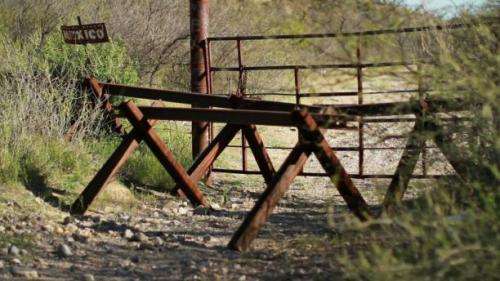Migrant deaths near peak highs, despite decrease in unauthorized migration

(Medical Xpress)—A report released June 5 by the Binational Migration Institute at the University of Arizona answers key questions about migrant deaths in Southern Arizona since 1990.
Authored by researchers from the Binational Migration Institute as well as from the Pima County Office of the Medical Examiner, or PCOME, the report finds that deaths during migration in Southern Arizona have not decreased despite the overall decrease in unauthorized migration border-wide.
The report finds that the "death rate" (the number of deaths per 100,000 Border Patrol apprehensions of unauthorized migrants) has increased exponentially in Border Patrol's Tucson sector since the early 2000s.
The report, titled, "A Continued Humanitarian Crisis at the Border: Undocumented Border Crosser Deaths Recorded by the Pima County Office of the Medical Examiner, 1990-2012," includes data on more than 2, 200 decedents examined by the PCOME and believed to be undocumented border crossers, or UBCs.
The interdisciplinary report was co-authored by researchers and professionals from the disciplines of sociology, cultural and forensic anthropology, Mexican American studies and pathology. Key findings on changes over time:
- Migrants from countries other than Mexico – mostly Central Americans – have increased from 9 percent of all deaths between 2000-05 to 17 percent in the 2006-12 time period.
- The number of female migrants examined by the PCOME rose from 13 percent of all deaths between 1990-99 to 23 percent in the 2000-05 era, and then leveled off at 16 percent in the time period covering 2006-12.
- When comparing the number of human remains discovered to the number of Border Patrol apprehensions of unauthorized migrants, the rate of migrant deaths per 100,000 apprehensions in 2011 was nearly double what it was in 2009.
"Although unauthorized migration flows are near 20-year lows in the Tucson sector, the number of deaths has not decreased substantially, but rather has remained near peak highs in the region," said Daniel E. Martínez, the study's first author and an assistant professor in the department of sociology at The George Washington University.
"And the death rate hasn't decreased either. This is concerning, especially considering the increase in migrant deaths and death rates in other areas of the border such as South Texas," he said.
Key findings on the demographics of decedents:
- The average deceased border crosser between 1990 and 2012 was male, around age 30, and from central or Southern Mexico.
- 13 percent of decedents were between 10 and 19 years of age, while 37 percent were between 20 and 29 years old.
"These are young people in the prime of life," said Bruce Anderson, co-author on the report and forensic anthropologist at the Pima County Office of the Medical Examiner. "They are impoverished people coming here in the hopes of supporting their families."
Robin Reineke, a doctoral candidate in the School of Anthropology at the UA and co-author on the report, said, "We are able to see signs of poverty and economic distress written on their bodies and represented in the items they are carrying."
Key findings on cause of death:
- The leading cause of death changed from exposure in the time period of 1990 to 2005, to undetermined, between 2006-12, a shift suggesting that remains are being discovered in more remote areas and in a more decomposed state.
- Migrants dying in motor vehicle accidents has decreased steadily, from 20 percent of all UBC deaths from 1990-99, to 11 percent from 2000-05, and then to 7 percent in the time period of 2006-12.
- There was no change in the percentage of decedents determined to have died from homicide, which remained at 4 percent of all UBC decedents from 2000-12.
Dr. Gregory Hess, chief pathologist at the Pima County Office of the Medical Examiner, said it is the job of the medical examiner to determine identity and cause of death "regardless of the legal status of the deceased."
Dr. Bruce Parks, now retired after acting as chief pathologist from 1991 to 2011 said, "We have always tried to treat each person with the same level of respect and scientific rigor when investigating their death."
"We never imagined that we would have to update our work" said Raquel Rubio- Goldsmith of the Binational Migration Institute, referring to an early report published on the topic by the institute in 2006.
"We had all hoped that the deaths would have ended by now. The fact that they haven't should be of grave concern to everyone at a moment in time when we have this historic opportunity for comprehensive immigration reform."

















